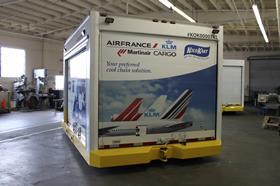
Air France KLM Martinair Cargo has announced that it is to roll out Kold Kart technology following a successful trial.
Developed by Tofflemire Freight Service, Kold Kart is a temperature-controlled air cargo container transport dolly that allows perishable air cargo to be delivered to and from the door of an aircraft under constant refrigeration.
The airport tarmac is regularly cited as the weak link in the air cargo cold chain, with perishable shipments often exposed to extreme temperatures while waiting to be loaded onto an aircraft and delays a frequent occurrence.
This is particularly the case for locations – such as Mexico – where high temperatures are experienced on a regular basis and where the ramp operations are quite distant from the warehouse.
Kold Kart prevents perishable cargo shipments from heating up before and after flight thereby reducing the risk involved in shipping perishable cargo by air. It means shipments arrive at their destination with higher product quality and a longer shelf life.
Once perishable containerised cargo is delivered to the airline for shipping and officially weighed and checked in for a flight, they are immediately placed inside a Kold Kart dolly. The dolly is then moved onto the tarmac area and held until it is pulled by a tug to the outbound aircraft.
The Kold Kart has a conveyor floor that permits container shipments to easily roll into and out of the dolly, and is fully compatible with Air France’s palletised unit loading devices.
For inbound shipments, perishable containers are off-loaded from the aircraft directly into the Kold Kart dolly that is then transported to the cargo building. Cargo containers are held inside a Kold Kart dolly at any temperature requested until the customer recovers the shipment.
“After a thorough test period of technical evaluation it clearly appeared that Kold Kart technology is the right answer to preserve the temperature integrity requested,” Air France said. “This innovative solution enhances the whole cool chain lifetime, thus protecting the commodities while reducing waste and extending the shelf life of products.”



